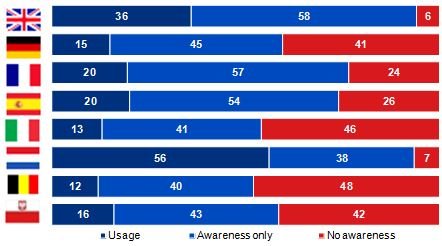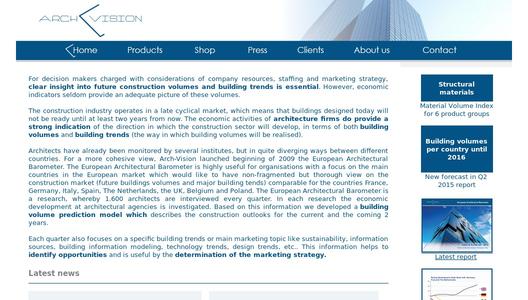We can clearly see that the United Kingdom and the Netherlands are at the forefront of BIM knowledge as well as BIM usage, as respectively 36% of the British architects use BIM and among Dutch architects it is even 56%. In these two countries organizations are not only forced by the market to start using BIM, it is also demanded by clients. Optimization of own business processes is also an important advantage of BIM and this is often mentioned as main reason why organizations started with BIM. Furthermore, France and Spain are really upcoming countries when it comes to the familiarity and usage of BIM. The familiarity with BIM increased massively among architects in Spain and France compared to 2013. In France a bigger growth is seen in the usage of BIM compared to the other European countries. The government of France is actively promoting the use of BIM among its architects. The plan to develop 500,000 houses using BIM by 2017 is one of the main reasons why BIM in France is getting more attention. Next to the risen number of architects working with BIM in the past two years in France, another 22% of the architects think they will start using BIM in the coming year. Only 13% of the architects in the Netherlands that are familiar with BIM have no plans start working with it, again a clear indicator that the Netherlands is at the forefront of BIM usage.
While in the Netherlands more than half of the architects already have implemented BIM in their organisation, other European countries are lagging behind. Clearly many architects still see major limitations which makes them reluctant to use BIM. Architects who are familiar with BIM on the other see many advantages of BIM as well. They report that the speed, better planning and high exchangeability are the success factors of BIM. However, limitations of BIM have to be overcome in order to fully exploit BIM. The most mentioned limitations of BIM are its complexity and the fact that it takes more time. The time consuming aspect of BIM especially has to do with the fact that architects need to put in a lot of data directly at the start of a new BIM supported project. Furthermore multiple parties are involved in BIM supported projects, which can make everything more complex and time consuming. Also the expenses of starting with BIM is a reason for many architects why they haven’t start working with it.
Building information modeling, also known as BIM, is a widely discussed topic in the construction sector and the expectations related to BIM are quite high. BIM is a new method that affects an entire organization and can deliver business advantages. The various parties involved at a project use a BIM model in which all information and agreements are recorded. In this way, the parties are supported in the design, construction and management process of a project. A smooth communication and a progress of the project through good
cooperation, that is among other things what BIM is really about. A more effective and efficient performance can be achieved during a project through better managing of the documentation during a project.
These and many other results and trends of the developments of the European construction market can be found in the European Architectural Barometer, an international market research conducted among 1,600 architects in Europe. This study is conducted in Germany, France, Italy, Spain, the United Kingdom, the Netherlands, Belgium and Poland by Arch-Vision four times a year. The research covers the developments of architectural turnover, order volumes and the impact of the crisis. Besides these economic statistics, a specific topic is highlighted each quarter. The topic in Q4 2015 was “Building Information Modeling (BIM)”. Architects can be used not only as a reliable source for future building volumes information, but their role is very important as they have great influence on how projects are built and which materials are used.


